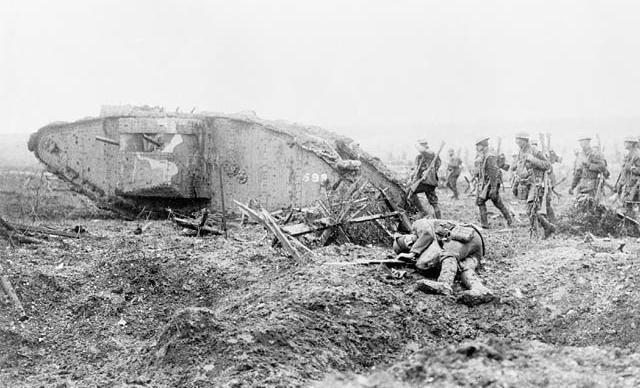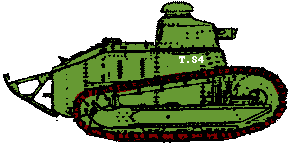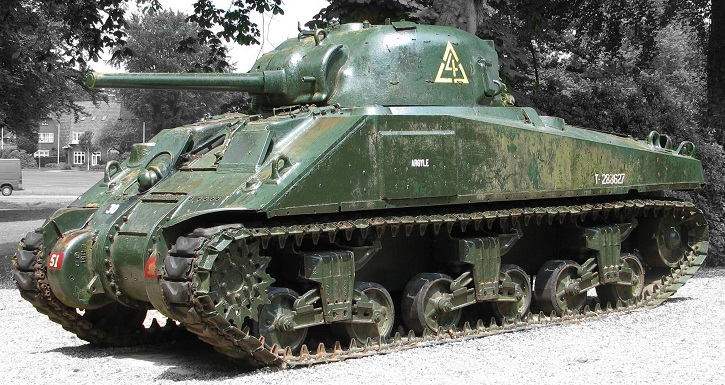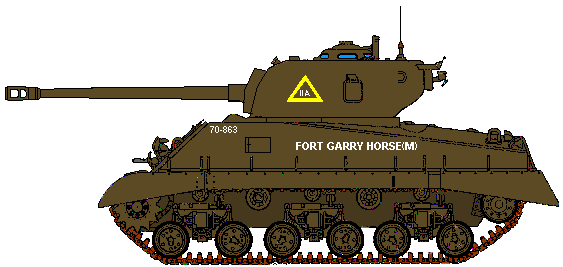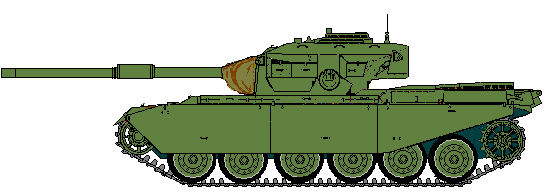|
|
|
|
|
Main Battle Tanks Main Battle Tank is a modern designation of a type of armoured fighting vehicle (AFV), describing a vehicle designed to function as the mainstay of an armoured force. Tank designations during the Second World War generally focused on the weight of the vehicle and/or the thickness of its armour, dividing tanks into "light", "medium" and "heavy" classifications. Main Battle Tanks of the Second World War tended to be in the "medium" category. Early HistoryThe tank had its roots in the First World War, as is well known; however, Canada did not employ in combat any tank units until the Second World War. Motorized machine gun units, using wheeled vehicles, had been very successfully employed by the Canadians in the First World War, but disbanded at war's end in 1918. Seven British tanks went into action with the Motor Machine Gun Brigade at Courcelette.
British tracked vehicles again supported Canadian infantry at Amiens in August 1918. A Canadian Tank Corps was created in 1918, with three battalions that was disbanded in 1920.2
The question of acquiring armoured vehicles did not come up again until 1927. A recommendation to acquire four tracked Mark I tanks was not heeded, and a long acquisition process began in which Canadian-built wheeled armoured cars were developed. The Canadian Militia (as the Army was known until 1940) was slow to mechanize, and the value of horses versus the value of tanks was hotly debated between the wars. Horsed cavalry units stayed in existence until after the Second World War began in 1939. Six infantry regiments were designated (Tank) units in 1936, but remained part of the infantry branch. Initially, no tanks were available for training. A Canadian Tank School was established in Camp Borden that year, becoming the Canadian Armoured Fighting Vehicle School in 1938. A handful of Carden-Loyd carriers had been purchased in the early 1930s for training, and some British Mk. VI B Light Tanks arrived in Canada in 1938. Still, no tanks were available for the six Tank regiments, nor at the school - all part-time units of the Non-Permanent Active Militia - to train with. The first large delivery of modern tanks arrived in the summer of 1939. Tank ClassificationsInfantry and Cruiser TanksTank classification in the Second World War was done at first by intended role, and then by weight (though the designations "light", "medium" and "heavy" generally refer to a combination of firepower, armour protection, and speed in addition to physical size). The most common means of differentiation has been between tanks intended to focus on fighting against infantry, and tanks intended for fighting against other tanks or other armoured vehicles. The British and American armies both chose to differentiate in this manner between the world wars. In the United States Army, it was felt that tanks would never have to fight other tanks; this was the job of the Tank Destroyer units. Tanks were for breakthrough fighting and infantry support. In the British Army, tanks at the start of the war were divided into Infantry and Cruiser tanks; Infantry tanks were slow (by design, no faster than a running infantryman), heavily armoured, and intended to clear obstacles to the advance of the infantry, while Cruiser tanks were faster, less heavily armoured, and intended to be used for independent action and fighting other armoured vehicles. While weight-based classifications were useful during the Second World War, this was only true when referencing other tanks of the period. Light tanks at the end of World War Two had progressed so far in terms of weight, gun size, armour, and speed that in 1939 they would have been considered "heavy" tanks. Tank classification has traditionally been determined by the prevailing theories of armoured warfare; these in turn have been altered by rapid technological change, so no one classification system works across all periods. Medium TanksDuring the Second World War, as tacticians formulated more practical means of fighting with armour, generally as part of combined-arms teams, tank classification shifted to a system of classification by weight. Fast, inexpensive light tanks were used for reconnaissance, while medium tanks became more of a general-purpose tank. Heavy tanks were slower, more heavily armoured, and heavily armed; the most famous examples were the German King Tiger or Soviet Josef Stalin tanks. The Canadian Army began to move away from Infantry and Cruiser tanks and towards light and medium tanks; by 1943 the Canadian Army had decided to exclusively use North American made tanks. Medium tanks became general purpose platforms, as in practice, the Allies found that enemy tanks could not be solely the responsibility of specialized anti-tank or tank destroyer units. The medium tank developed into a compromise of armour, speed, mobility, and firepower, especially in response to German technical innovation. Main Battle TanksAfter the Second World War, specialized vehicles took over the reconnaissance role, and tank development merged the best characteristics of medium and heavy tanks into a new category of tank - the Main Battle Tank. Advances in technology, tank design and new materials for armour meant that capabilities could be increased without resorting to "heavy" designs, though weights did in fact increase. The development of HEAT ammunition (High Explosive, Anti-Tank) during the Second World War made steel impractical, and new materials such as Chobham armour began to be be employed. Vulnerability of tanks to HEAT rounds (easily carried by infantrymen and potentially plentiful on the post WW II battlefield in a variety of weapons of increasing range) meant that mobility and weapons power became more important factors in AFV design than armour protection. The phrase Main Battle Tank grew to have international acceptance, and described a tank armed and armoured to deal with as many different types of threats as possible. TrainingThe CAFVS became the Canadian Armoured Fighting Vehicle Training Centre after the outbreak of war. Vickers Valentine Mark VI
The first tanks fielded in Canada in the Second World War were sixteen Mark VI "Valentine" tanks. The Mark VI was a British design, built exclusively in Canada, and had a Browning machine gun in place of the British Besa model co-axial machine gun.
GrizzlyAn improved version of the Ram called the Grizzly was planned during 1942; very similar to the American M4 (see below), this vehicle would mount a 75mm or high velocity 76mm main armament. By mid-January 1943, an order for 80 percent of the materials needed to produce 1200 Grizzlies had been placed, with hopes that the vehicles would be assembled by February 1944. During the summer of 1943, however, discussions between Canadian and British authorities settled the matter of using U.S. Shermans for all four Canadian armoured brigades overseas (as well as the two armoured reconnaissance regiments, who would go into action outfitted as armoured regiments). Tank production in Canada was to shift to production of 50 Grizzlies per month (to a maximum of 250), and 150 Sexton self-propelled guns per month. The Grizzly was eventually abandoned as a medium tank and plans to convert the 250 chassis to self-propelled anti-aircraft guns was initiated; 188 hulls were eventually built but decline in German air power led to the anticipated 360 vehicles not being needed. Few turrets were actually completed and none were ever used to engage a German aircraft.3 Tank Units in Action
The first tank formation of the Canadian Army to arrive overseas was the 1st Canadian Army Tank Brigade (consisting of the 11th, 12th, and 14th Canadian Army Tank Battalions), landing in the UK in July 1941. It was immediately issued with eighteen Mk IIA Matildas (eight of these going to the 14th Canadian Army Tank Battalion) and four Mark IV Churchills. By September 1941, the entire brigade had 62 tanks of all types, or 116 short of its establishment of 178. By October, the 14th CATB alone had 49 Matildas. The Brigade was originally to be organized with two battalions of Matildas and one battalion of Churchill tanks. While British officers did not like the Churchill, Brigadier Worthington, commanding the 1st Canadian Army Tank Brigade, requested that all three of his battalions be issued with the Churchill. By February 1942, this was nearly achieved, with four early Covenanter type Cruiser tanks in the brigade headquarters squadron, and 160 Churchills of an establishment of 174 on strength.
In November 1941 the 14th CATB had 15 Churchills and 31 Matildas on strength. December saw the 14th with 35 Churchills. In May the unit was redesignated a Tank Regiment. In July 1942 the war establishment was set at 40 officers and 630 Other Ranks. The Churchills of the 14th went into action on 19 August 1942 at Dieppe. The terrain in which the tanks operated was poor, and rocks from the chert beach broke track pins on several vehicles. Concrete barriers on the beach exits were not removed when the Engineers assigned to that task were killed or unable to advance off the beach. The tank crews, however, lost no casualties to enemy fire while in their vehicles due to the heavy armour. The crews stayed at their posts until all ammunition was expended, covering the withdrawal of the infantry from the beach; few men of the (14th Canadian Army Tank Regiment (Calgary Regiment)) made it back to England. In March 1943, the Brigade had the Churchills replaced by the Canadian Ram tank. The Rams were on issue only a short while before the decision was made to send the Brigade to Sicily. In May 1943, the Rams were themselves replaced with the Sherman Mark V in time for the invasion of Sicily in July 1943 These Shermans came from British stocks. The unit kept the Shermans until the end of the war. In March 1945, after transfer to Northwest Europe, the Firefly was issued to the Regiment, on a scale of two per troop, though squadrons were now reduced to four troops. Two troops of 105mm gun armed Shermans remained at Squadron Headquarters.  The 2nd Canadian Army Tank Brigade was formed on 26 January 1942, with Les Voltigeurs de Québec, The Halifax Rifles, and The Grey and Simcoe Foresters under command (in June 1942 the Voltigeurs were replaced with The 16/22 Saskatchewan Horse. The formation was equipped with Ram II tanks, with the brigade training by autumn of 1942 at the newly opened Meaford AFV range on Georgian Bay.  The 3rd Canadian Army Tank Brigade was dispatched to the United Kingdom in June 1943, consisting of The 1st Hussars, The Fort Garry Horse, and The Sherbrooke Fusilier Regiment. In July 1943 both brigades were inspected by Lieutenant-General Harry Crerar, General Officer Commanding I Canadian Corps, and the 3rd was selected to remain on the order of battle of First Canadian Army. The 3rd Canadian Tank Brigade was redesignated 2nd Canadian Tank Brigade, and then reorganized as 2nd Canadian Armoured Brigade, and would act as an independent formation in the invasion of Europe. No infantry Motor battalion was assigned to it, and the brigade was assigned to the British 2nd Army in January 1944 to begin training for its role in Operation OVERLORD, the invasion of Normandy. The brigade's three regiments landed in Normandy on D-Day equipped with Sherman tanks, included Duplex Drive Shemans. The formation usually tasked out its regiments separately to provide tank support to infantry formations. The 2nd Armoured Brigade did not receive Shermans until April and May of 1944, as the policy was to use Ram tanks for training and issue Shermans only for operational use. Assault brigades in 21 Army Group were equipped with the Sherman III (M4A2) due to shortages of the Sherman V (M4A4).  The First Canadian Armoured Division was raised in February 1941, as experience in the Western Desert saw an increased understanding of the capabilities of armour in modern warfare. By June 1941, the division had been renamed the 5th Canadian (Armoured) Division, and was organized along British lines, with two armoured brigades. The division moved to the UK at the end of 1941, and in 1943 was heavily reorganized, moving to a new organization calling for one brigade of infantry and one of armour. The Division was issued with Ram II tanks beginning in March 1942. Of an establishment of 340 tanks, only 80 Ram II tanks, without guns or mounts, were shipped to the UK during the year. General Lee and Grant tanks were issued in the interim; on 31 August 1942 23 Grants were on charge, being used by both the 4th and 5th Divisions. The Division was re-equipped with Sherman tanks on arrival in Italy in late 1943, with heavy equipment drawn from British stocks; these vehicles were often well worn from use in the desert and Sicily/Italy fighting and had belonged to units now rotated back to the UK to train for the Normandy landings.
The 4th Armoured Division did not receive Shermans until April and May of 1944, as the policy was to use Ram tanks for training and issue Shermans only for operational use. Assault brigades in 21 Army Group were equipped with the Sherman III (M4A2) due to shortages of the Sherman V (M4A4). Mark IIA* (Matilda) Infantry TankSmall numbers of Matildas were used in the UK in 1941 before the decision to equip completely with Churchills was made. Mark IV (Churchill) Infantry Tank
After the Battle of France in 1940, the British Army had an acute need for tank replacements, and a pre-war design known as the A20 was pushed into production. The vehicle was very much reminiscent of Great War armour, being long and able to negotiate wide trenches and cratered ground, with a top speed no greater than that of a running man. The A20 reached prototype form by June 1940, the month that France surrendered, and developed into the A22 by November of that year. The first production vehicles were available in the middle of 1941, as Canadian armoured units were arriving in Great Britain. The vehicle entered service with many mechanical problems and defects and was not popular among British officers, but General Worthington enthusiastically asked for his Canadian armoured crews in the UK to be equipped with it exclusively. The Churchills in use with the Canadian Army in 1941-42 were Mark IV, mounting a 6-pounder main armament and deleting a hull mounted 3-inch howitzer found in earlier models. In May 1942, the "Gun Carrier, Churchill, Mark I" was issued to the Heavy Support Company of the 1st Tank Brigade, and nine of these vehicles were used in the anti-tank role during training, until this unit was broken up in February 1943. Before the raid on Dieppe, many "reworked" Churchills, of earlier marks, were issued to the 14th Canadian Army Tank Regiment. Three Churchill II tanks with flamethrowers - known as "Oke" - were among the tanks of the Dieppe force. Later Marks of the Churchill showed much mechanical improvement, and though Canadians stopped using them shortly after Dieppe, were widely used in the British Army, chiefly in independent tank brigades. As well, many "funnies" were developed from the Churchill, including AVsRE (Armoured Vehicles, Royal Engineers) and the Crocodile, a flamethrowing variant that was used by the British 79th Armoured Division. Lee and GrantThe British, desperate for tanks in 1942 due to heavy losses in the North African fighting, ordered M3 Medium tanks from the US after being unable to have British designs built in US factories. Unhappy with the high silhouette of the M3 - which they called the "General Lee", they produced their own turret. The new turret (which, when fitted, converted a "Lee" into a "Grant"), deleted the commander's cupola and also moved the No. 19 wireless set to the turret instead of the hull. This move also reduced the number of crewmen from 6 to 5. While the Grant was fitted with a 75mm gun, the sponson mounting meant that hull-down positions could not be achieved; the turret retained the increasingly ineffective 37mm gun. Nonetheless, the tank was used successfully in the Western Desert. Canadian units in the UK used 47 Lee and Grant tanks after the British were able to obtain sufficient numbers of Shermans. The hull and suspension of the M3 design were also adapted by Canadian industry to develop the Ram.
Ram Mark IIThe decision to equip Canadian armoured units overseas with the Ram tank was made as early as 1941. Production quotas for 1942 for 1155 Ram tanks were not met, however, due to delays associated with reliance on American parts (the Ram was based on the US M3 chassis) as well as sharing the Canadian assembly line with the production of Sexton self-propelled guns. By 1 June 1943, 1147 Ram tanks were in the United Kingdom with the Canadian Army, sufficient to fill the needs of all armoured units of that formation. Unfortunately, by the time the vehicles were fully in service, it was realized the 6-pounder armament (57mm) was inadequate to deal with German armour nor was it particularly useful as an anti-infantry weapon. With the adoption of the 75mm main gun by the Americans in their M4 tanks (called Shermans by the British and Canadians), it was desired to have equally powerful tank guns in the Commonwealth forces. In March 1943 it was decided to upgrade 600 Rams with several modifications, chiefly the installation of 75mm main armament, with 1000 more Rams being reserved for training purposes. In practice, it proved impossible to modify the Ram due to the amount of work it would entail, and a decision was made to adopt the M4 Sherman for Canadian use overseas. In addition to the 75mm gun, the Sherman was found to have better performance driving off-road and was actually easier to drive. Total production of the Ram was 1949 vehicles; some 500 were made available to the British War Office for conversion to Assault Vehicles, Royal Engineers (AVRE), 277 remained in Canada for training purposes, and 104 had been lost at sea during shipment to Europe. The total number of Rams shipped overseas by December 1945 was 1567.
Sherman III and Sherman VSee also main article: Sherman Tank. The story of the American M4 family of tanks is fairly well known; in British service it was first used in the late summer of 1942, at the time of the El Alamein battles in North Africa. Called the M4 by the American, the British dubbed them "General Shermans" and several models saw service with them. In the spring of 1943, the Sherman began to equip Canadian units as well, as described above. The M4 chassis was an improved version of the M3 chassis used on Lee and Grant tanks (as well as the Canadian Ram). The Sherman III (in American parlance known as the M4A2) had a twin diesel engine (GM6-71) unique to this model (as well as the M10 tank destroyer (or self-propelled anti-tank gun in Canadian jargon). The Sherman V was longer, to accommodate the Chrysler multi-bank aviation engine (known to the Americans as the M4A4).
Sherman FireflyA policy of mounting 17-pounder guns on British tanks was also carried over to the Canadians; while initially a goal of 15 so-equipped tanks per regiment was difficult to maintain, tank units in NW Europe eventually achieved a scale of issue of 2 per four tank troop. The Sherman V was the original vehicle used for this weapon - which had the bow machine gun and co-driver deleted to make room for ammunition, and the radio located to a special box on the back of the turret, to accommodate the larger breach of the gun. This configuration was known as the Firefly, or Sherman Vc. The Sherman I was also used for the 17-pounder gun, the result being the Sherman Ic. The 17-pounder had dramatically improved performance against German armour.
The 29th Canadian Armoured Reconnaissance Regiment (South Alberta Regiment ) did not receive Sherman Fireflies until September 1944, about a month after landing in Normandy with the 4th Canadian (Armoured) Division. "By the spring of 1945 there were enough of these AFVs to provide each troop with two 17-pounder gun tanks."5 Sherman Fireflies also began appearing in Italy in late 1944. See the main article on Sherman tanks for more details.
Sherman DDThe three regiments of the 2nd Armoured Brigade, when used in the assault role in Normandy, had 38 DD or Duplex Drive Shermans issued; these were tanks fitted with canvas sides and propellers so as to enable them to swim to shore from landing craft and immediately cover assaulting infantry once ashore. In the event, less than half these tanks actually swam to shore, the others being set on the beach directly.
Sherman 105Shermans mounting 105mm howitzers began to be issued to tank regiments in Italy on a scale of six per regiment towards the end of 1944. They were designated Sherman Ib. As they were not available in North-West Europe, the regiments retained them when they shipped from Italy during Operation GOLDFLAKE in early 1945.
Comparative Data: Second World War Tanks
Post Second World WarIn 1945 Canada left almost all its wartime vehicles in Europe rather than paying to ship them back to Canada. What little armour Canada retained was a mixture of wartime Achilles tank-destroyers as well as Grizzly and Stuart tanks. In 1946 the Royal Canadian Armoured Corps was equipped with 300 M4A2 76mm (W) HVSS Shermans, which were purchased from the United States at a cost of $1,460.00 each. They were used for training only. The M4A2 76mm (W) HVSS. The (W) referred to "wet" stowage for the ammunition, the HVSS refers to Horizontal Volute Spring Suspension, a type of suspension adopted during the war by the Americans, whose earlier Sherman models - like the Ram - had Vertical Volute Spring Suspension. Reserve units were also to use the Staghound armoured car. While officially policy since 1943 was to use North American manufactured vehicles as much as possible in the Canadian Army, the British Centurion so impressed the Canadians that it was adopted in 1952, receiving 274 Centurion Mark 3 tanks in 1952-53. One squadron of tanks was employed in Korea. At first it was anticipated that M10 Achilles Tank Destroyers would be used, but these were exchanged for the M4A3(76)W HVSS Sherman, also supplied by the United States. This American designed tank was used by the three successive squadrons of Lord Strathcona's Horse to serve with the 25th Canadian Brigade during hostilities. The Centurions went to Canadian units in West Germany beginning in March 1952, and to units in Canada. Sherman M4A2 76mm (W) HVSSThe US produced 2,915 M4A2 Shermans between May 1944 and May 1945, intended for export to the Soviet Union under Lend-Lease, until the end of the war in Europe halted the program. Some 49,243 of all Sherman types had been built during the war, and used by many of the Allied nations. The regular army used the vehicles until the Centurions was adopted, and the Shermans were handed down to the Militia who used them until 1970. Many became range targets, and several have become monuments (sometimes referred to as "gate guards".)
Centurion (1952-1979)Part of the planned Americanization of Canadian weapons and equipment after the Second World War centred on finding a new medium tank to replace the fleet of Shermans that had been left in The Netherlands. Canada was using a mixture of Achilles tank destroyers, M4A2 HVSS 76(W) Shermans, Grizzlies, and Stuart light tanks and Staghound armoured cars for training. Experience in the Korean War showed a need for better tanks than the Americans had on inventory; even the new Patton tank was at that time having a troubled production history. In Korea, however, the fire control system and gun of the Centurion proved its worth, and Canada took delivery of 274 Mark 3 Centurions in 1952 and 1953. The planned policy of using only North American equipment had already been derailed by the Korean War and the need to equip the infantry from war stocks of Lee Enfields, Bren Guns and Sten Guns. The first 21 Centurions reached the Royal Canadian Dragoons in Germany in March 1952 and serving with Canada's NATO forces there. No Canadian Centurions made it to Korea, and the tanks were used in Canada and Europe through the 1960s and into the 1970s. The new tank was well liked, having a .50 calibre ranging gun in the turret to assist in determining the range to main gun targets. The sophisticated optics and ammunition types, however, provided a challenge to new gunners as each of the different ammunition types (sabot, High Explosive Squash Head (HESH), smoke and canister) all had differing muzzle velocities. The .30 and .50 calibre guns fired rounds on about the same trajectory as the HESH round; other rounds had to have the main gun adjusted according to muzzle velocity of the ammunition, as well as range, in order to ensure a hit on the target. The Centurion Mark 3 was quickly upgraded into a variety of configurations.
In August 1971, according to Don Dingwall's book The Centurion in Canadian Service, the national inventory was:
By 1975, the once state-of-the-art tank was beginning to show its age, though as late as 1975 Canadian gunners could still outscore other tank types by considerable margins in exercises. The unsynchronized gearbox was also tricky for drivers to master, and faulty shifting could leave the 55 ton tanks rolling free in neutral on downward slopes, a condition nicknamed "Mexican Overdrive."6 The Centurions were used, with several life extension schemes, until 2 June 1977 when the Royal Canadian Dragoons in Lahr, West Germany held a final parade with the vehicles. Some Centurions continued in service in Canada until 1979, until replacement tanks (the Leopard) were received.
Cougar AVGPAfter the Sherman tanks were withdrawn from Militia armoured regiments in the early 1970s, they had no AFVs to train on in their home garrisons until the arrival of the Armoured Vehicle, General Purpose (AVGP) in 1976. The Cougar was just one model of AVGP to see service in Canada; it was designated a "tank trainer" (though later would be sent on operations dubbed a "fire support vehicle") and issued to Militia units and also Regular Force armoured units. The vehicle was armed with a 76mm gun capable of firing a variety of munitions, as well as a co-axial C6 Machine Gun. Leopard C1 (1979) The Leopard 1 main battle tank was developed by Germany in the 1960s. Canada purchased 127 Leopard 1A3 tanks (built by Krauss-Maffei Wehrtechnik GmbH) in 1979, the bulk of which were stationed in West Germany until Canada's withdrawal from Europe after the Cold War ended. The tank had a fully stabilized 105mm gun capable of firing while the vehicle was moving. The Leopard also has a 7.62mm C-6 MG mounted co-axially, a C-6 on the turret roof for anti-aircraft defence, and smoke dischargers. The Canadian Forces upgraded the 1A3 with add-on armour plating.
Leopard C2 (1994)The Leopard C1 retrofitted with a German Leopard 1A5 turret with improved (thermal) sights, as well as composite add-on armour, was known as the Leopard C2. The thermal sights allowed for operation at night and in battlefield visibility conditions obscured by smoke, dust or fog. The upgrading of the Leopards into C2 configuration began in 1994 and was completed in September 2001 at a cost of $139 million. A number of desired upgrades proved too costly (at $400 million) such as improved firepower, armour protection, and electric turret drive. The thermal sight and digital fire control system took priority; the most effective way to achieve this was to replace 114 C1 turrets with surplus German Leopard 1A5 turrets, which already had the thermal sights and fire control systems in place. The new turrets were reconditioned in Germany, fitted with Canadian specific components such as an Iris communication system, external stowage baskets, and an internal spall liner. The turrets were installed at Miramichi, New Brunswick and the vehicles were then commissioned at CFB Gagetown. Nine spare turrets were acquired for spare parts, test equipment and use as training aids. According to an article by Lieutenant Colonel Luc Petit in Volume 4, Number 34 of the Maple Leaf:
Comparative Data: Postwar Tanks
Notes
|
||||||||||||||||||||||||||||||||||||||||||||||||||||||||||||||||||||||||||||||||||||||||||||||||||||||||||||||||||||||||||||||||||||||||||||||||||||||||||||||||||||||||||||||||||||||||||||||||||||||||||||||||||||||
© canadiansoldiers.com 1999-present
